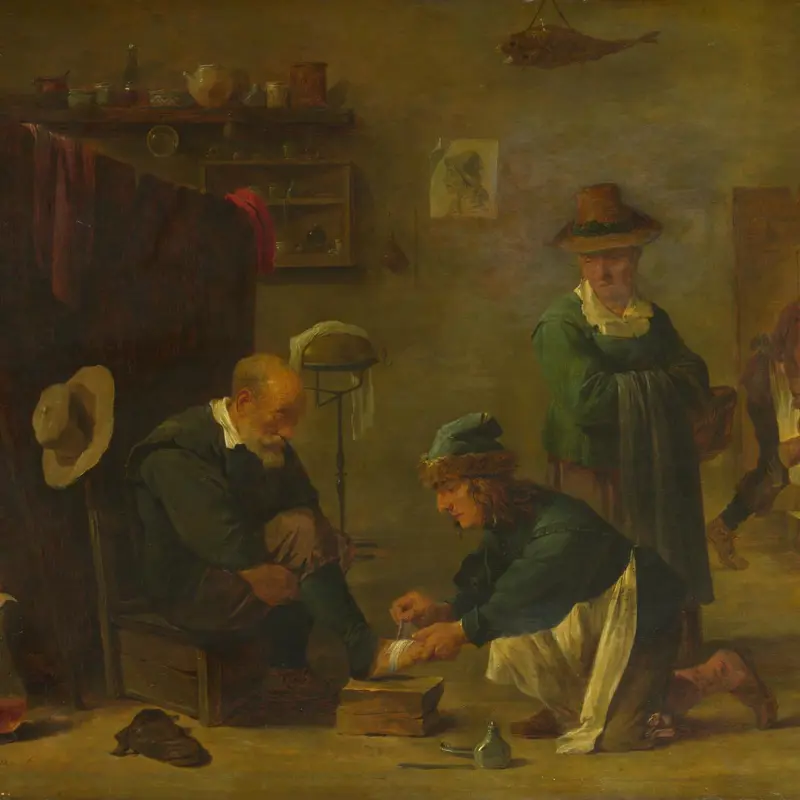David Teniers the Younger, 'Peasants at Archery', about 1645
About the work
Overview
A towering rain cloud seems to threaten an early close to this game of archery. Perhaps the storm will come as a relief – although the archer takes aim with an eager eye, only one of the three arrows already shot has hit the target. The game seems almost incidental, however: Teniers is here telling a secondary tale that, on careful viewing, takes the more important role in the picture. Only the two players, the seated man and the umpire seem interested in the archery. Most of the others appear to be up to mischief.
Teniers depicted peasants as caricatures repeated against unidentified, probably imaginary backgrounds. They are like the characters from the popular commedia dell’arte and often appear to be involved in a scam; here, the pompous man in the black hat seems ripe for exploitation, and a lively figure in a red hat runs between two groups of plotters. With pictures like these, a wealthy collector could enjoy the commedia dell’arte without stirring from his fireside.
Key facts
Details
- Full title
- Peasants at Archery
- Artist
- David Teniers the Younger
- Artist dates
- 1610 - 1690
- Date made
- About 1645
- Medium and support
- Oil on canvas
- Dimensions
- 119.4 × 289.6 cm
- Inscription summary
- Signed
- Acquisition credit
- Bequeathed by Mrs Mary Venetia James from the Arthur James collection, 1948
- Inventory number
- NG5851
- Location
- Not on display
- Collection
- Main Collection
Provenance
Additional information
Text extracted from the ‘Provenance’ section of the catalogue entry in Gregory Martin, ‘National Gallery Catalogues: The Flemish School: circa 1600–circa 1900’, London 1986; for further information, see the full catalogue entry.
Bibliography
-
1831Catalogue of Pictures by Italian, Spanish, Flemish, Dutch, and English Masters, with which the Proprietors have Favoured the Institution, June 1831, London 1831
-
1842J. Smith, Supplement to the: A Catalogue Raisonné of the Works of the Most Eminent Dutch, Flemish, and French Painters: In Which is Included a Short Biographical Notice of the Artists, with a Copious Description of Their Principal Pictures […], vol. 9, London 1842
-
1955The National Gallery, The National Gallery: 1938-1954, London 1955
-
1970G. Martin, The Flemish School, circa 1600-circa 1900, London 1970
-
1978F.P. Dreher, The Vision of Country Life in the Paintings of David Teniers II, Ann Abor 1978
-
1986Martin, Gregory, National Gallery Catalogues: The Flemish School, circa 1600 - circa 1900, London 1986
-
1991M. Klinge, David Teniers de Jonge: Schilderijen, tekeningen (exh. cat. Koninklijk Museum voor Schone Kunsten, 11 May - 1 September 1991), Ghent 1991
-
1995M. Díaz Padrón, El siglo de Rubens en el Museo del Prado: Catálogo razonado de pintura flamenca del siglo XVII, Madrid 1995
-
2001
C. Baker and T. Henry, The National Gallery: Complete Illustrated Catalogue, London 2001
About this record
If you know more about this work or have spotted an error, please contact us. Please note that exhibition histories are listed from 2009 onwards. Bibliographies may not be complete; more comprehensive information is available in the National Gallery Library.























